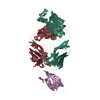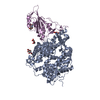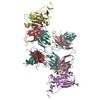+ Open data
Open data
- Basic information
Basic information
| Entry | Database: PDB / ID: 7te1 | ||||||||||||
|---|---|---|---|---|---|---|---|---|---|---|---|---|---|
| Title | SARS-CoV-2 Receptor Binding Domain in Complex with Ab17 | ||||||||||||
 Components Components |
| ||||||||||||
 Keywords Keywords | IMMUNE SYSTEM/Viral Protein / antibody-antigen complex / SARS-CoV-2 / receptor binding domain / IMMUNE SYSTEM / IMMUNE SYSTEM-Viral Protein complex | ||||||||||||
| Function / homology |  Function and homology information Function and homology informationsymbiont-mediated disruption of host tissue / Maturation of spike protein / Translation of Structural Proteins / Virion Assembly and Release / host cell surface / host extracellular space / viral translation / symbiont-mediated-mediated suppression of host tetherin activity / Induction of Cell-Cell Fusion / structural constituent of virion ...symbiont-mediated disruption of host tissue / Maturation of spike protein / Translation of Structural Proteins / Virion Assembly and Release / host cell surface / host extracellular space / viral translation / symbiont-mediated-mediated suppression of host tetherin activity / Induction of Cell-Cell Fusion / structural constituent of virion / membrane fusion / entry receptor-mediated virion attachment to host cell / Attachment and Entry / host cell endoplasmic reticulum-Golgi intermediate compartment membrane / positive regulation of viral entry into host cell / receptor-mediated virion attachment to host cell / host cell surface receptor binding / symbiont-mediated suppression of host innate immune response / receptor ligand activity / endocytosis involved in viral entry into host cell / fusion of virus membrane with host plasma membrane / fusion of virus membrane with host endosome membrane / viral envelope / symbiont entry into host cell / virion attachment to host cell / SARS-CoV-2 activates/modulates innate and adaptive immune responses / host cell plasma membrane / virion membrane / identical protein binding / membrane / plasma membrane Similarity search - Function | ||||||||||||
| Biological species |  Homo sapiens (human) Homo sapiens (human) | ||||||||||||
| Method |  X-RAY DIFFRACTION / X-RAY DIFFRACTION /  SYNCHROTRON / SYNCHROTRON /  MOLECULAR REPLACEMENT / MOLECULAR REPLACEMENT /  molecular replacement / Resolution: 3.5 Å molecular replacement / Resolution: 3.5 Å | ||||||||||||
 Authors Authors | Hauser, B.M. / Schmidt, A.G. | ||||||||||||
| Funding support |  United States, 3items United States, 3items
| ||||||||||||
 Citation Citation |  Journal: Cell Rep / Year: 2022 Journal: Cell Rep / Year: 2022Title: Rationally designed immunogens enable immune focusing following SARS-CoV-2 spike imprinting. Authors: Blake M Hauser / Maya Sangesland / Kerri J St Denis / Evan C Lam / James Brett Case / Ian W Windsor / Jared Feldman / Timothy M Caradonna / Ty Kannegieter / Michael S Diamond / Alejandro B ...Authors: Blake M Hauser / Maya Sangesland / Kerri J St Denis / Evan C Lam / James Brett Case / Ian W Windsor / Jared Feldman / Timothy M Caradonna / Ty Kannegieter / Michael S Diamond / Alejandro B Balazs / Daniel Lingwood / Aaron G Schmidt /  Abstract: Eliciting antibodies to surface-exposed viral glycoproteins can generate protective responses that control and prevent future infections. Targeting conserved sites may reduce the likelihood of viral ...Eliciting antibodies to surface-exposed viral glycoproteins can generate protective responses that control and prevent future infections. Targeting conserved sites may reduce the likelihood of viral escape and limit the spread of related viruses with pandemic potential. Here we leverage rational immunogen design to focus humoral responses on conserved epitopes. Using glycan engineering and epitope scaffolding in boosting immunogens, we focus murine serum antibody responses to conserved receptor binding motif (RBM) and receptor binding domain (RBD) epitopes following severe acute respiratory syndrome coronavirus 2 (SARS-CoV-2) spike imprinting. Although all engineered immunogens elicit a robust SARS-CoV-2-neutralizing serum response, RBM-focusing immunogens exhibit increased potency against related sarbecoviruses, SARS-CoV, WIV1-CoV, RaTG13-CoV, and SHC014-CoV; structural characterization of representative antibodies defines a conserved epitope. RBM-focused sera confer protection against SARS-CoV-2 challenge. Thus, RBM focusing is a promising strategy to elicit breadth across emerging sarbecoviruses without compromising SARS-CoV-2 protection. These engineering strategies are adaptable to other viral glycoproteins for targeting conserved epitopes. | ||||||||||||
| History |
|
- Structure visualization
Structure visualization
| Structure viewer | Molecule:  Molmil Molmil Jmol/JSmol Jmol/JSmol |
|---|
- Downloads & links
Downloads & links
- Download
Download
| PDBx/mmCIF format |  7te1.cif.gz 7te1.cif.gz | 240.1 KB | Display |  PDBx/mmCIF format PDBx/mmCIF format |
|---|---|---|---|---|
| PDB format |  pdb7te1.ent.gz pdb7te1.ent.gz | 189.3 KB | Display |  PDB format PDB format |
| PDBx/mmJSON format |  7te1.json.gz 7te1.json.gz | Tree view |  PDBx/mmJSON format PDBx/mmJSON format | |
| Others |  Other downloads Other downloads |
-Validation report
| Summary document |  7te1_validation.pdf.gz 7te1_validation.pdf.gz | 462.5 KB | Display |  wwPDB validaton report wwPDB validaton report |
|---|---|---|---|---|
| Full document |  7te1_full_validation.pdf.gz 7te1_full_validation.pdf.gz | 479.3 KB | Display | |
| Data in XML |  7te1_validation.xml.gz 7te1_validation.xml.gz | 40.6 KB | Display | |
| Data in CIF |  7te1_validation.cif.gz 7te1_validation.cif.gz | 55.8 KB | Display | |
| Arichive directory |  https://data.pdbj.org/pub/pdb/validation_reports/te/7te1 https://data.pdbj.org/pub/pdb/validation_reports/te/7te1 ftp://data.pdbj.org/pub/pdb/validation_reports/te/7te1 ftp://data.pdbj.org/pub/pdb/validation_reports/te/7te1 | HTTPS FTP |
-Related structure data
| Related structure data |  4hclS  4l5fS  6m0jS S: Starting model for refinement C: citing same article ( |
|---|---|
| Similar structure data | Similarity search - Function & homology  F&H Search F&H Search |
- Links
Links
- Assembly
Assembly
| Deposited unit | 
| ||||||||||
|---|---|---|---|---|---|---|---|---|---|---|---|
| 1 |
| ||||||||||
| Unit cell |
|
- Components
Components
| #1: Antibody | Mass: 23975.820 Da / Num. of mol.: 2 Source method: isolated from a genetically manipulated source Source: (gene. exp.)  Homo sapiens (human) / Cell line: HEK 293-F / Cell line (production host): HEK 293-F / Production host: Homo sapiens (human) / Cell line: HEK 293-F / Cell line (production host): HEK 293-F / Production host:  Homo sapiens (human) Homo sapiens (human)#2: Antibody | Mass: 23363.680 Da / Num. of mol.: 2 Source method: isolated from a genetically manipulated source Source: (gene. exp.)  Homo sapiens (human) / Cell line (production host): HEK 293-F / Production host: Homo sapiens (human) / Cell line (production host): HEK 293-F / Production host:  Homo sapiens (human) Homo sapiens (human)#3: Protein | Mass: 23771.750 Da / Num. of mol.: 2 Source method: isolated from a genetically manipulated source Source: (gene. exp.)  Homo sapiens (human) / Gene: S, 2 / Cell line (production host): HEK 293S GntI -/- / Production host: Homo sapiens (human) / Gene: S, 2 / Cell line (production host): HEK 293S GntI -/- / Production host:  Homo sapiens (human) / References: UniProt: P0DTC2 Homo sapiens (human) / References: UniProt: P0DTC2Has protein modification | Y | |
|---|
-Experimental details
-Experiment
| Experiment | Method:  X-RAY DIFFRACTION / Number of used crystals: 1 X-RAY DIFFRACTION / Number of used crystals: 1 |
|---|
- Sample preparation
Sample preparation
| Crystal | Density Matthews: 3.29 Å3/Da / Density % sol: 62.65 % |
|---|---|
| Crystal grow | Temperature: 291.15 K / Method: vapor diffusion, hanging drop / pH: 7 Details: 0.1 M HEPES pH 7.0 and 30% v/v Jeffamine ED-2001 pH 7.0 |
-Data collection
| Diffraction | Mean temperature: 100 K / Serial crystal experiment: N |
|---|---|
| Diffraction source | Source:  SYNCHROTRON / Site: SYNCHROTRON / Site:  APS APS  / Beamline: 21-ID-E / Wavelength: 0.9792 Å / Beamline: 21-ID-E / Wavelength: 0.9792 Å |
| Detector | Type: DECTRIS EIGER X 16M / Detector: PIXEL / Date: Jul 26, 2021 |
| Radiation | Protocol: SINGLE WAVELENGTH / Monochromatic (M) / Laue (L): M / Scattering type: x-ray |
| Radiation wavelength | Wavelength: 0.9792 Å / Relative weight: 1 |
| Reflection | Resolution: 3.5→79.99 Å / Num. obs: 24539 / % possible obs: 99.98 % / Redundancy: 21.1 % / Biso Wilson estimate: 104.62 Å2 / Rmerge(I) obs: 0.395 / Rpim(I) all: 0.088 / Rrim(I) all: 0.405 / Net I/σ(I): 10.1 |
| Reflection shell | Resolution: 3.5→3.55 Å / Num. unique obs: 4607 / CC1/2: 0.235 / % possible all: 100 |
-Phasing
| Phasing | Method:  molecular replacement molecular replacement |
|---|
- Processing
Processing
| Software |
| ||||||||||||||||||||||||||||||||||||||||||||||||||||||||||||||||||||||
|---|---|---|---|---|---|---|---|---|---|---|---|---|---|---|---|---|---|---|---|---|---|---|---|---|---|---|---|---|---|---|---|---|---|---|---|---|---|---|---|---|---|---|---|---|---|---|---|---|---|---|---|---|---|---|---|---|---|---|---|---|---|---|---|---|---|---|---|---|---|---|---|
| Refinement | Method to determine structure:  MOLECULAR REPLACEMENT MOLECULAR REPLACEMENTStarting model: 6M0J, 4L5F, 4HCl Resolution: 3.5→79.99 Å / SU ML: 0.5915 / Cross valid method: FREE R-VALUE / σ(F): 1.36 / Phase error: 37.5634 Stereochemistry target values: GeoStd + Monomer Library + CDL v1.2
| ||||||||||||||||||||||||||||||||||||||||||||||||||||||||||||||||||||||
| Solvent computation | Shrinkage radii: 0.9 Å / VDW probe radii: 1.11 Å / Solvent model: FLAT BULK SOLVENT MODEL | ||||||||||||||||||||||||||||||||||||||||||||||||||||||||||||||||||||||
| Displacement parameters | Biso mean: 95.58 Å2 | ||||||||||||||||||||||||||||||||||||||||||||||||||||||||||||||||||||||
| Refinement step | Cycle: LAST / Resolution: 3.5→79.99 Å
| ||||||||||||||||||||||||||||||||||||||||||||||||||||||||||||||||||||||
| Refine LS restraints |
| ||||||||||||||||||||||||||||||||||||||||||||||||||||||||||||||||||||||
| LS refinement shell |
|
 Movie
Movie Controller
Controller





 PDBj
PDBj




